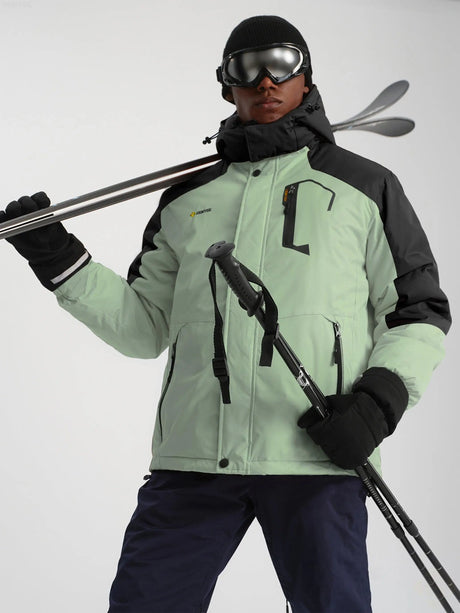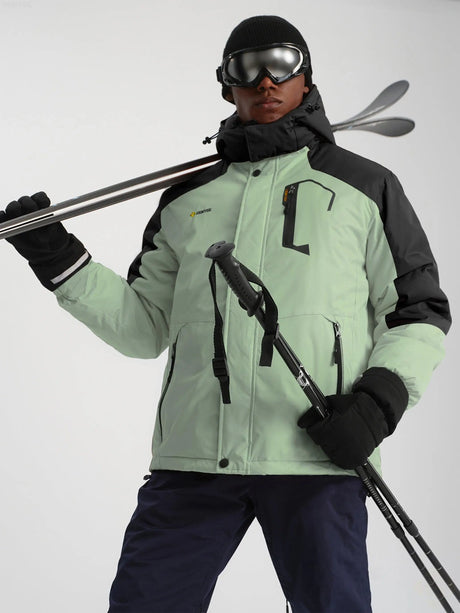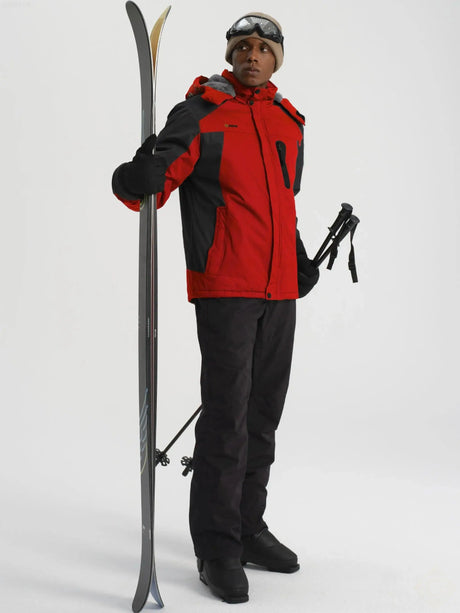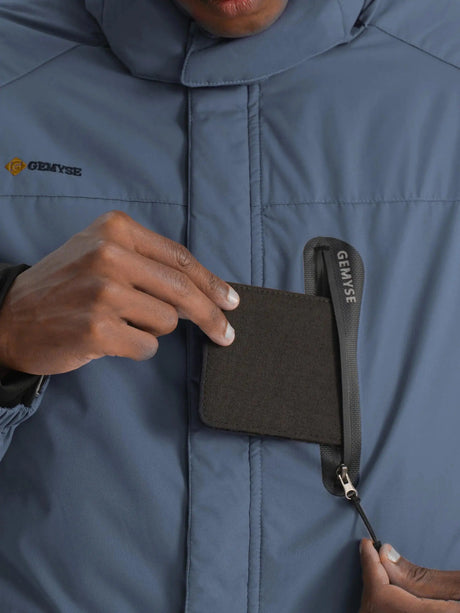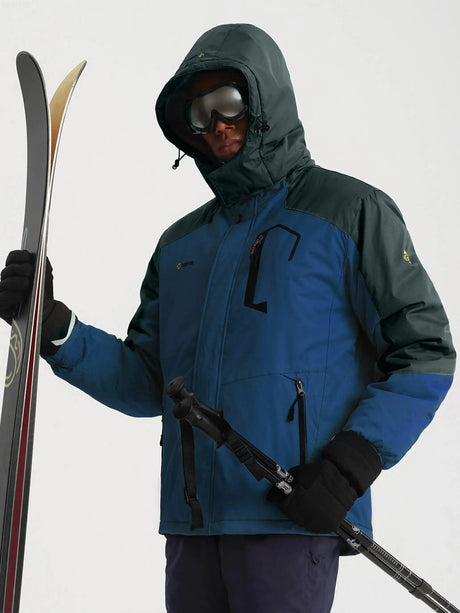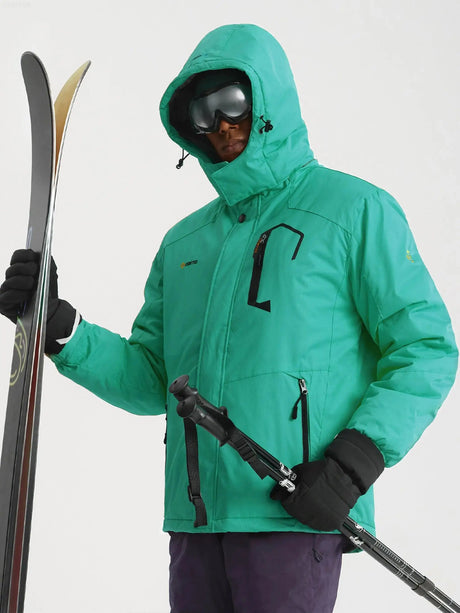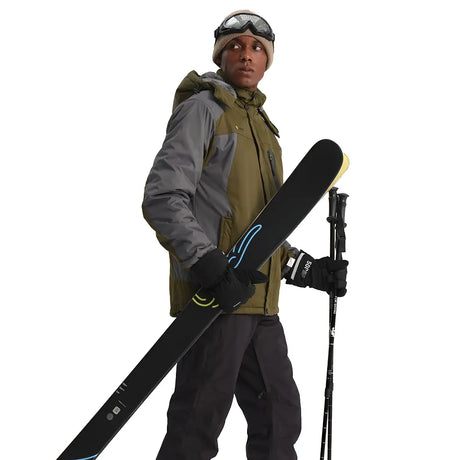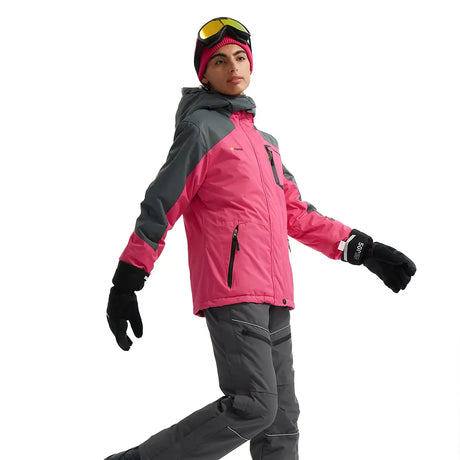what to look for in a ski jacket
Choosing the right ski jacket is crucial for a great skiing experience. It keeps you warm, dry, and comfortable on the slopes.
With so many options available, finding the perfect one can be overwhelming.
This guide will help you understand what to look for in a ski jacket.
We'll explore different types, from insulated to shell jackets.
Waterproofing and breathability are key features to consider.
We'll also cover sizing guides from top brands like Helly Hansen and Arc'teryx.
Whether you're a beginner or a seasoned skier, this guide is for you.
Get ready to find the best ski jacket for your needs.
Why the Right Ski Jacket Matters
A ski jacket is more than just a piece of clothing. It's essential for enjoying your time on the slopes. The right jacket provides warmth, protection, and comfort in cold, wet conditions.
A good ski jacket enhances your skiing experience. It protects against wind, snow, and unpredictable weather changes. You’ll appreciate this when temperatures drop or snow turns to sleet.
When skiing, mobility is key. A well-designed jacket ensures you can move freely. It won't restrict your movements, allowing you to focus on your technique.
Comfort and functionality are important for long days outdoors. Look for features that enhance your jacket, such as:
- Adjustable hoods
- Snow skirts
- Plenty of pockets
Price can reflect quality and durability. Investing in a good ski jacket often means better performance and a longer lifespan.
Types of Ski Jackets Explained
Selecting the right ski jacket involves understanding the different types available. Each type is tailored for specific weather and style preferences. There are four main types of ski jackets you should consider. Each has its own set of advantages based on conditions and personal needs. Here’s a quick breakdown:
- Insulated Ski Jackets
- Shell Ski Jackets
- 3-in-1 Ski Jackets
- Softshell Ski Jackets
Insulated jackets offer extra warmth, perfect for cold climates. Shell jackets are versatile for layering, adjusting to changing conditions easily. The 3-in-1 jackets provide adaptability with removable layers. Finally, softshell jackets balance flexibility and breathability for comfort.
Knowing these types helps in matching the right jacket to your skiing environment. Each design is aimed at maximizing comfort while facing the elements. Consider climate and activity intensity when choosing your jacket type. Layering is crucial, and understanding the primary jacket types aids in making informed decisions. Ultimately, the best choice depends on personal preference and skiing demands.

Insulated Ski Jackets
Insulated ski jackets are designed for warmth. They contain built-in insulation that keeps you cozy on bitter days. The insulation can be natural down or synthetic. Down is known for its excellent warmth-to-weight ratio. However, synthetic insulation performs better in wet conditions.
These jackets are ideal when temperatures dip significantly. Insulated jackets might be heavier, but they save the hassle of layering excessively. Consider the following features when choosing an insulated jacket:
- Type of insulation (down or synthetic)
- Waterproofing capabilities
- Breathability to manage moisture
These jackets are perfect for keeping you warm without piling on layers. They’re a great choice for those who prefer staying warm effortlessly.

Shell Ski Jackets
Shell jackets are known for their versatility. They don’t come with built-in insulation, allowing layering flexibility. You can adjust warmth by varying underlayers. This makes them suitable for varied conditions.
Shell jackets protect against wind and water effectively. They're lightweight, making them ideal for activities requiring mobility. When opting for a shell jacket, consider these aspects:
- Waterproofing and windproof capabilities
- Adjustable features like hoods
- Compatibility with layering
This jacket type is excellent for skiers who want adaptability and control over warmth. They allow you to stay prepared for changing weather.

3-in-1 Ski Jackets
The 3-in-1 ski jacket offers maximum flexibility. It combines an outer shell with an inner insulating layer. Each layer can be worn independently or together. It adapts well to diverse weather conditions.
This system is perfect for those wanting one jacket for all situations. Switching between layers accommodates temperature changes easily. Here are key points to consider:
- Layer compatibility
- Ease of attachment/detachment
- Overall weight of combined layers
Such jackets provide excellent value and adaptability. They ensure you're equipped for a range of skiing environments.

Softshell Ski Jackets
Softshell ski jackets prioritize comfort and breathability. They're lighter and more flexible compared to other jackets. Designed for mild to moderate conditions, they offer a good balance.
Softshells excel in lighter snow, where mobility is important. They might lack heavy-duty waterproofing, but compensate with comfort. Consider the following when selecting a softshell:
- Flexibility and stretch
- Light water resistance
- Breathability for active skiing
These jackets suit skiers aiming for comfort, particularly in mild winter conditions. They're an excellent choice for those wanting ease of movement.

Key Features to Look for in a Ski Jacket
When buying a ski jacket, certain features are essential. These features ensure protection, comfort, and functionality. The right jacket should keep you warm and dry while allowing easy movement. Start by checking the waterproofing and breathability. These factors prevent external moisture while managing internal sweat.
Look for adjustable components like hoods and cuffs for a snug fit. This adaptability enhances wind protection and warmth retention. Insulation type is another important consideration. Choose between down and synthetic based on weather needs.
Here is a quick checklist of features:
- Waterproof and breathable fabric
- Quality insulation (down or synthetic)
- Adjustable hoods and cuffs
Additionally, consider convenient storage options. Pockets for gear and personal items are practical. Seek jackets with ski-specific features like snow skirts. These features prevent snow from entering during falls. Comfort and warmth are equally crucial. A well-designed jacket strikes a perfect balance.

Waterproofing: Stay Dry on the Slopes
Waterproofing is a critical element in ski jackets. It keeps you dry during snowy adventures. Check the waterproof rating, measured in millimeters. Higher numbers indicate better resistance to moisture.
Materials with taped seams offer superior protection. They prevent water from seeping through stitch lines. Look for durable water repellent (DWR) treatments. These treatments add an extra layer of defense against wetness.
Essential waterproof features include:
- High waterproof rating
- Fully taped seams
- DWR-treated fabric
An effective waterproof jacket keeps snow and sleet out. This ensures you remain comfortable and focused on skiing. Investing in a waterproof jacket enhances outdoor performance. Prioritize waterproofing when making your choice.

Breathability: Prevent Overheating
While waterproofing is vital, breathability is equally important. It allows moisture to escape, preventing overheating. Skiing involves intense physical activity that generates heat. Breathable materials let sweat evaporate, ensuring comfort.
Evaluate breathability ratings alongside waterproof measures. Vents or zippers under arms can enhance airflow. Consider these breathability features:
- Breathable fabric rating
- Ventilation zippers or mesh linings
- Moisture-wicking inner layers
Maintaining temperature control is crucial for a pleasant ski experience. A breathable jacket keeps internal moisture at bay. This balance between waterproofing and breathability is key for comfort.

Insulation: Warmth Without Bulk
Insulation is necessary for warmth in cold conditions. Quality insulation keeps heat trapped, without the bulk. This allows ease of movement while staying cozy. Choose between down or synthetic based on climate needs.
Down insulation is lightweight and compressible. Synthetic performs well when wet, offering reliable warmth. Key insulation factors include:
- Type: Down vs. synthetic
- Warmth-to-weight ratio
- Moisture management
Effective insulation makes skiing enjoyable in cold weather. It minimizes layering hassles, providing consistent warmth. Consider insulation needs based on expected temperatures.

Fit and Mobility: Move with Ease
Fit and mobility are crucial for skiing agility. A well-fitting jacket ensures ease of movement on slopes. Consider your usual layers when assessing fit. A snug fit should not restrict mobility.
Articulated sleeves provide natural arm movement, crucial for skiing. Features to consider include:
- Proper fit size for layering
- Articulated sleeves
- Stretch panels for flexibility
Jackets with a balanced fit enhance skiing prowess. They allow freedom without compromising warmth. Properly fitted jackets improve skiing skills and comfort.

Additional Features: Hoods, Cuffs, Pockets, and More
A well-thought-out ski jacket incorporates additional features. These include adjustable hoods, cuffs, and practical pockets. Hoods should accommodate helmets, providing added protection.
Cuffs that adjust ensure no snow sneaks inside. Pockets keep essentials handy, like maps and energy bars. Other notable features might include:
- Helmet-compatible hoods
- Adjustable cuffs
- Ample and secure pockets
These features enhance utility and convenience on the slopes. Jackets designed with skiers in mind make ski trips more enjoyable. Choose a jacket with well-rounded features for optimum performance.

Sizing Guides from Top Brands
Choosing the correct ski jacket size is essential for comfort and performance. Leading ski brands offer detailed size guides to assist buyers. These guides focus on measurements that ensure a perfect fit. Using them helps in selecting jackets that fit well over layers. Well-fitted jackets enhance mobility and warmth during skiing.
Brands like Helly Hansen, Arc'teryx, Roxy, and Salomon have comprehensive guides. They provide size charts that simplify choosing the right jacket. Checking these charts is a crucial step before purchasing. It avoids common sizing mistakes, making for a satisfying purchase.
Important measurements usually include chest, waist, and hips. Understanding these guides assists in finding a jacket that meets style preferences and functional needs.
Features typically highlighted in size guides:
- Key measurement points
- Variations in fit types
- Conversion charts for international sizing
Consulting brand-specific guides ensures a snug, comfortable fit. The right size maximizes protection against the elements.

Helly Hansen Ski Jacket Size Guide
Helly Hansen is known for precision in sizing. Their guide covers essential measurements like chest, waist, and hip sizes. It helps in choosing jackets that will fit over base layers.
Helly Hansen provides detailed conversion charts for global shoppers. This makes it easier for international purchases. The guide also suggests fit types, ensuring mobility while skiing.
Refer to the Helly Hansen size guide for:
- Detailed size charts
- Fit tips for layered clothing
- International size conversions
These size recommendations lead to a better fitting experience. Jackets following these guides provide superior comfort on slopes.

Arc'teryx Ski Guide Jacket & Size Guide
Arc'teryx is renowned for its quality and precise sizing details. Their size guide includes measurements critical for a good fit. Arc'teryx emphasizes material stretch and fit style, tailoring to active skiers.
Comprehensive size charts enhance your selection process. They also offer style recommendations, which helps in aesthetics preferences. Arc'teryx jackets are crafted for performance and style.
Arc'teryx guides include:
- Chest, waist, and hip measurements
- Style recommendations
- Material stretch and fit advice
Following this size guide ensures a well-fitted jacket. It complements the jacket's premium performance and durability.

Roxy Ski Jacket Size Guide
Roxy specializes in styles specifically for women. Their size guide caters to curves, providing fit details crucial for female skiers. With styles focusing on women's needs, Roxy stands out.
Their guide simplifies choosing sizes that offer both style and functionality. It outlines measurements that cater to various women’s body shapes.
The Roxy size guide includes:
- Women-specific fit tips
- Curved-friendly measurements
- Detailed size charts
Following the Roxy guide ensures comfort and style. This makes for a more enjoyable and fashionable skiing experience.

Salomon Ski Jacket Size Guide
Salomon's size guide provides precise measurements. It focuses on facilitating a snug and comfortable fit. Their size charts are user-friendly, guiding buyers in making informed choices.
Salomon emphasizes fit preferences like regular, slim, or loose. They advise on layering needs, ensuring your jacket accommodates added clothing without restriction.
Key aspects of the Salomon size guide:
- Fit preferences: regular, slim, loose
- Layering advice
- Easy-to-read size charts
Consult Salomon’s size guide to find your perfect fit. It enhances the skiing experience with comfort and function.

Best Ski Jackets: Top Picks and Reviews
Selecting the best ski jacket can significantly impact your skiing experience. Quality jackets offer the perfect balance of warmth, durability, and style. Evaluating popular models ensures you choose one that fits your needs.
Top brands often combine advanced fabric technology with practical design. As a result, they provide jackets that excel in various conditions. Consider factors like insulation, waterproofing, and breathability when selecting a jacket.
Reading reviews helps identify the strengths and weaknesses of different models. Reviews highlight how each jacket performs on the slopes. They also provide insights into user satisfaction. Performance in extreme conditions often distinguishes superior jackets.
Highly rated models frequently boast features such as:
- Adjustable hoods
- Multiple storage pockets
- Ventilation zippers
Researching and comparing top-rated jackets aids in finding a lasting option. Investing in the best coat enhances your comfort and protection while skiing.

Arc'teryx Ski Guide Jacket Review
The Arc'teryx Ski Guide Jacket is renowned for its exceptional quality. It caters to serious skiers who need reliability in harsh conditions. Made with top-notch materials, it offers both durability and comfort.
This jacket stands out for its impressive waterproofing. Snow and moisture don't penetrate, keeping skiers dry. Additionally, its breathability prevents overheating during intense activity. This balance is crucial for comfort on the slopes.
Key features of the Arc'teryx Ski Guide Jacket include:
- High-quality waterproof fabrics
- Efficient breathability
- Comfortable fit for active skiing
Reviews often praise its performance and styling. Skiers appreciate its reliability, especially in challenging weather. This jacket is an investment for those who value quality and durability.

Other Top Ski Jacket Recommendations
Beyond Arc'teryx, other ski jackets also receive high praise. Brands like North Face, Patagonia, and Columbia offer excellent alternatives. These jackets provide similar benefits in terms of warmth and protection.
The North Face jackets are known for their stylish appearance and functional design. Patagonia focuses on eco-friendly materials without compromising quality. Columbia jackets often integrate advanced technology for superior warmth.
Features that make these jackets popular:
- Innovative fabric technology
- Eco-friendly production processes
- Stylish and practical designs
Investing in any of these options ensures a reliable experience. Each jacket brand brings unique advantages, catering to various skier preferences. Consistently high reviews underline their value.

How to Choose the Best Ski Jacket for You
Finding the perfect ski jacket requires assessing specific needs and preferences. Start by considering the climate and conditions you'll face. Different regions demand varying levels of warmth and weather protection.
Assess the type of skiing you'll engage in—whether casual or extreme. Aggressive skiing often requires more durable materials. Comfort and flexibility enhance both enjoyment and performance.
Evaluate your budget to narrow down options. It's possible to find high-quality jackets at various price points. Prioritize features you can't compromise on.
Look for these essential qualities:
- Adequate insulation and waterproofing
- Flexibility and range of motion
- Practical features like pockets and adjustable components
Try on several options to determine the best fit. Comfort should be a top priority in your choice. A good-fitting jacket boosts your confidence and protection.

Care and Maintenance Tips for Your Ski Jacket
Proper care extends the life of your ski jacket. It maintains its performance and appearance. Regular cleaning prevents dirt buildup, affecting waterproofing.
Always check care labels before washing. Some jackets require special detergents to preserve waterproofing. Air drying is typically recommended over machine drying.
Store your jacket in a cool, dry place. Avoid placing it in direct sunlight for extended periods, as it can degrade materials.
Key care tips include:
- Follow manufacturer washing instructions
- Use specialized detergent if needed
- Avoid using fabric softeners
- Repair small rips or tears promptly
Implement these tips, and your jacket will stay in great condition for years.

Frequently Asked Questions About Ski Jackets
Ski jackets can be complex to newcomers. Many often ask what defines a quality ski jacket. Common inquiries revolve around waterproofing, warmth, and fit.
How do you know if a jacket is waterproof? Check the waterproof rating, typically in millimeters. The higher the number, the better the protection.
For further clarity, here are some frequently asked questions:
- How often should I clean my ski jacket?
- Does a more expensive jacket guarantee better quality?
- Can I wear my ski jacket casually?
These questions help guide your purchase decision and care routine. Understanding these basics ensures your jacket serves you well on and off the slopes.
Conclusion: Find Your Perfect Ski Jacket
The right ski jacket offers warmth, protection, and style. Understanding your needs and exploring options helps you make the right choice.
Whether it's versatility, comfort, or specific features you value most, there's a perfect jacket out there. Armed with this guide, you're prepared to find the best fit for your skiing adventures.


